Page 34 of 319
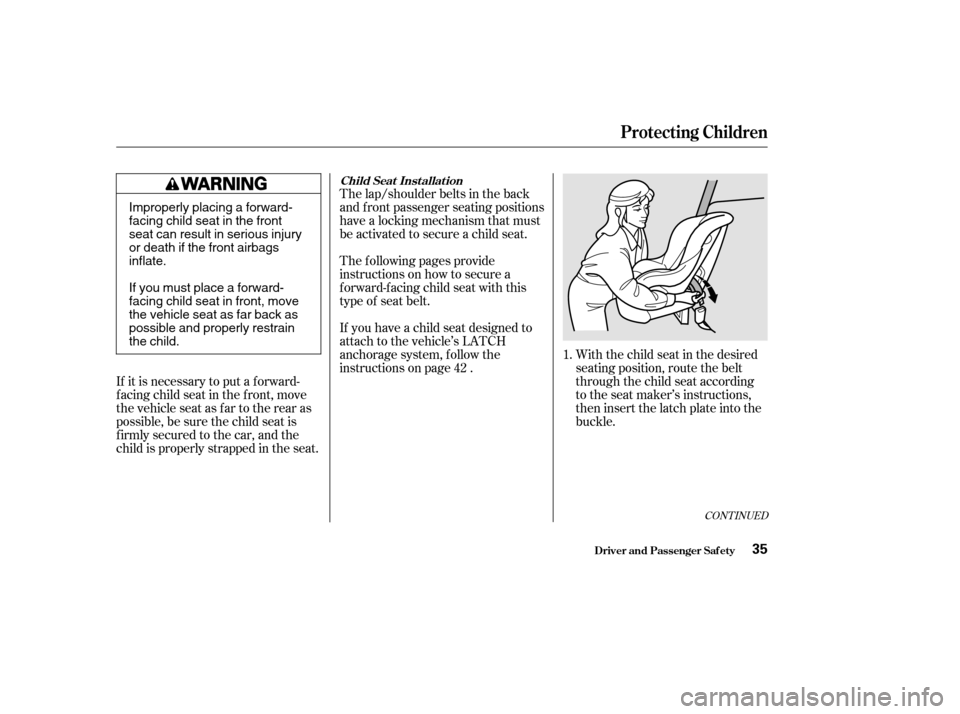
With the child seat in the desired
seating position, route the belt
through the child seat according
to the seat maker’s instructions,
then insert the latch plate into the
buckle.
The lap/shoulder belts in the back
and f ront passenger seating positions
have a locking mechanism that must
be activated to secure a child seat.
The f ollowing pages provide
instructions on how to secure a
f orward-f acing child seat with this
type of seat belt.
If it is necessary to put a f orward-
f acing child seat in the f ront, move
the vehicle seat as far to the rear as
possible, be sure the child seat is
f irmly secured to the car, and the
child is properly strapped in the seat. If you have a child seat designed to
attach to the vehicle’s LATCH
anchorage system, follow the
instructions on page .
1.
42
CONT INUED
Child Seat Inst allat ion
Protecting Children
Driver and Passenger Saf ety35
Improperly placing a forward-
facing child seat in the front
seat can result in serious injury
or death if the front airbagsinflate.
Ifyoumustplaceaforward-
facing child seat in front, move
the vehicle seat as far back as
possible and properly restrain
the child.
Page 35 of 319
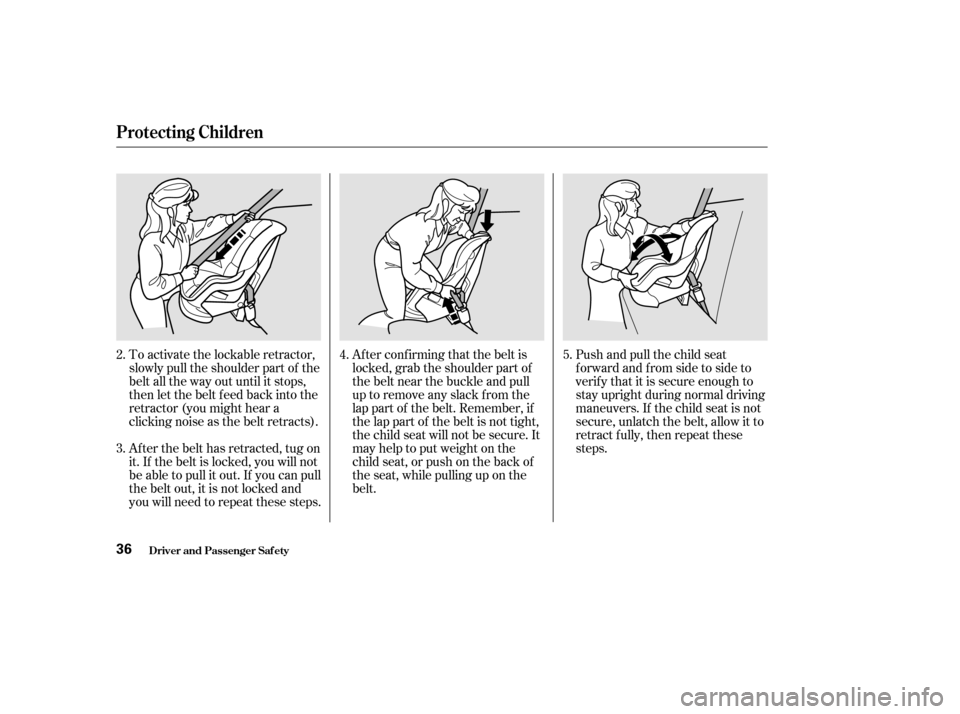
Push and pull the child seat
f orward and f rom side to side to
verif y that it is secure enough to
stay upright during normal driving
maneuvers. If the child seat is not
secure, unlatch the belt, allow it to
retract f ully, then repeat these
steps.
Af ter conf irming that the belt is
locked, grab the shoulder part of
the belt near the buckle and pull
up to remove any slack from the
lap part of the belt. Remember, if
the lap part of the belt is not tight,
the child seat will not be secure. It
mayhelptoputweightonthe
child seat, or push on the back of
the seat, while pulling up on the
belt.
To activate the lockable retractor,
slowly pull the shoulder part of the
belt all the way out until it stops,
then let the belt f eed back into the
retractor (you might hear a
clicking noise as the belt retracts).
Af ter the belt has retracted, tug on
it. If the belt is locked, you will not
be able to pull it out. If you can pull
the belt out, it is not locked and
you will need to repeat these steps. 4.
5.
2. 3.
Protecting Children
Driver and Passenger Saf ety36
Page 36 of 319
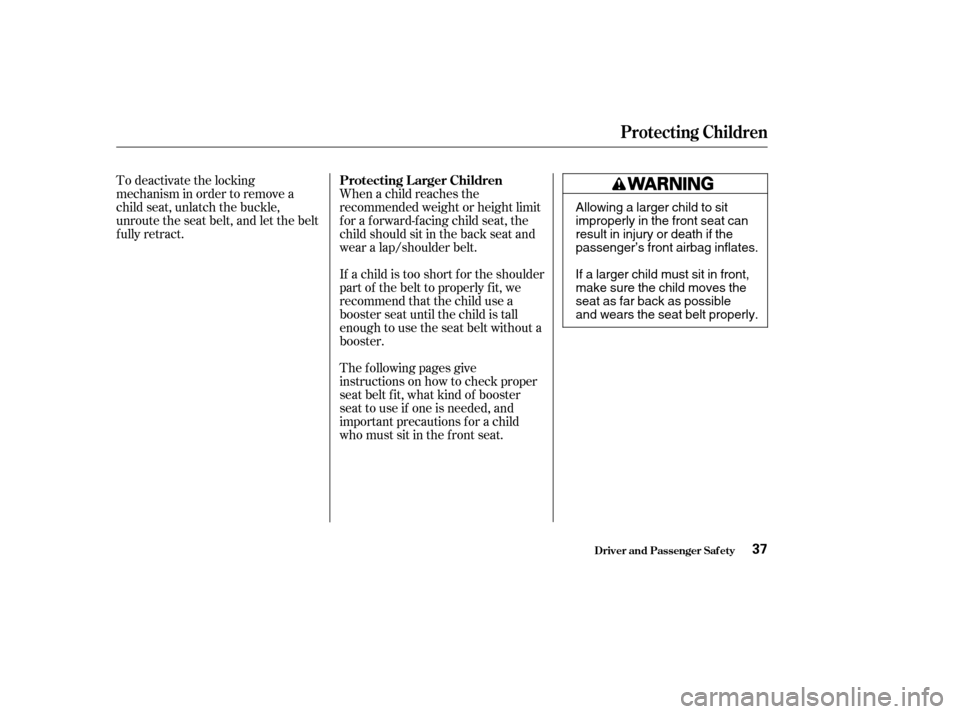
When a child reaches the
recommended weight or height limit
for a forward-facing child seat, the
child should sit in the back seat and
wear a lap/shoulder belt.
If a child is too short f or the shoulder
part of the belt to properly f it, we
recommend that the child use a
booster seat until the child is tall
enough to use the seat belt without a
booster.
The f ollowing pages give
instructions on how to check proper
seat belt f it, what kind of booster
seat to use if one is needed, and
important precautions f or a child
who must sit in the f ront seat.
To deactivate the locking
mechanism in order to remove a
child seat, unlatch the buckle,
unroute the seat belt, and let the belt
fully retract.
Protecting L arger Children
Protecting Children
Driver and Passenger Saf ety37
Allowing a larger child to sit
improperly in the front seat can
result in injury or death if the
passenger’s front airbag inflates.
If a larger child must sit in front,
make sure the child moves the
seat as far back as possible
and wears the seat belt properly.
Page 37 of 319
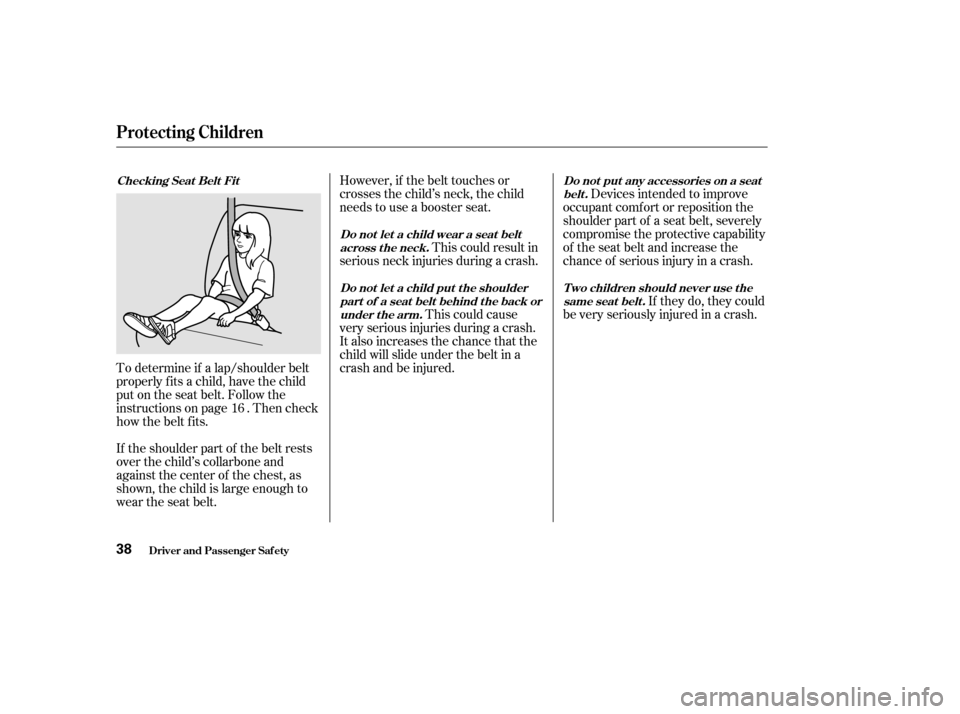
Devices intended to improve
occupant comf ort or reposition the
shoulder part of a seat belt, severely
compromise the protective capability
of the seat belt and increase the
chance of serious injury in a crash.
If they do, they could
be very seriously injured in a crash.
However, if the belt touches or
crosses the child’s neck, the child
needs to use a booster seat.
This could result in
serious neck injuries during a crash.
This could cause
very serious injuries during a crash.
It also increases the chance that the
child will slide under the belt in a
crash and be injured.
To determine if a lap/shoulder belt
properly f its a child, have the child
put on the seat belt. Follow the
instructions on page . Then check
how the belt f its.
If the shoulder part of the belt rests
over the child’s collarbone and
against the center of the chest, as
shown, the child is large enough to
wear the seat belt. 16
Do not put any accessories on a seat
belt.
T wo children should never use t hesame seat belt .
Do not let a child wear a seat belt
across t he neck.
Do not let a child put the shoulderpart of a seat belt behind t he back orunder t he arm.
Checking Seat Belt Fit
Protecting Children
Driver and Passenger Saf ety38
Page 38 of 319
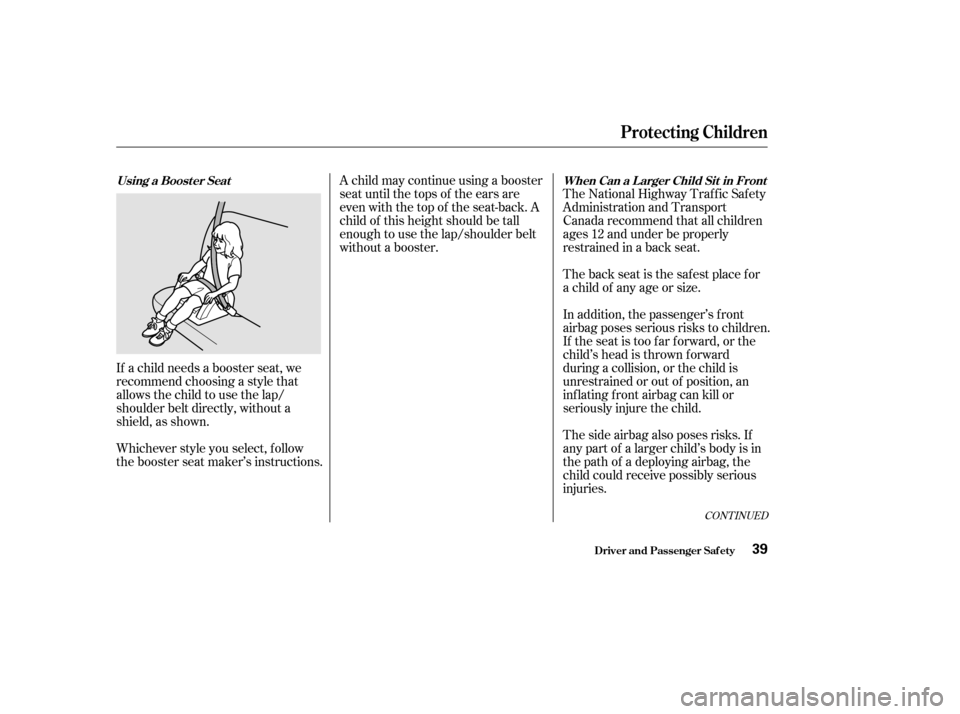
The back seat is the safest place for
a child of any age or size.
The National Highway Traffic Safety
Administration and Transport
Canada recommend that all children
ages 12 and under be properly
restrained in a back seat.
In addition, the passenger’s f ront
airbag poses serious risks to children.
If the seat is too f ar f orward, or the
child’s head is thrown f orward
during a collision, or the child is
unrestrained or out of position, an
inf lating f ront airbag can kill or
seriously injure the child.
The side airbag also poses risks. If
any part of a larger child’s body is in
the path of a deploying airbag, the
child could receive possibly serious
injuries.
A child may continue using a booster
seat until the tops of the ears are
even with the top of the seat-back. A
child of this height should be tall
enough to use the lap/shoulder belt
without a booster.
If a child needs a booster seat, we
recommend choosing a style that
allows the child to use the lap/
shoulder belt directly, without a
shield, as shown.
Whichever style you select, f ollow
the booster seat maker’s instructions.
CONT INUED
When Can a Larger Child Sit in Front
Using a Boost er Seat
Protecting Children
Driver and Passenger Saf ety39
Page 39 of 319
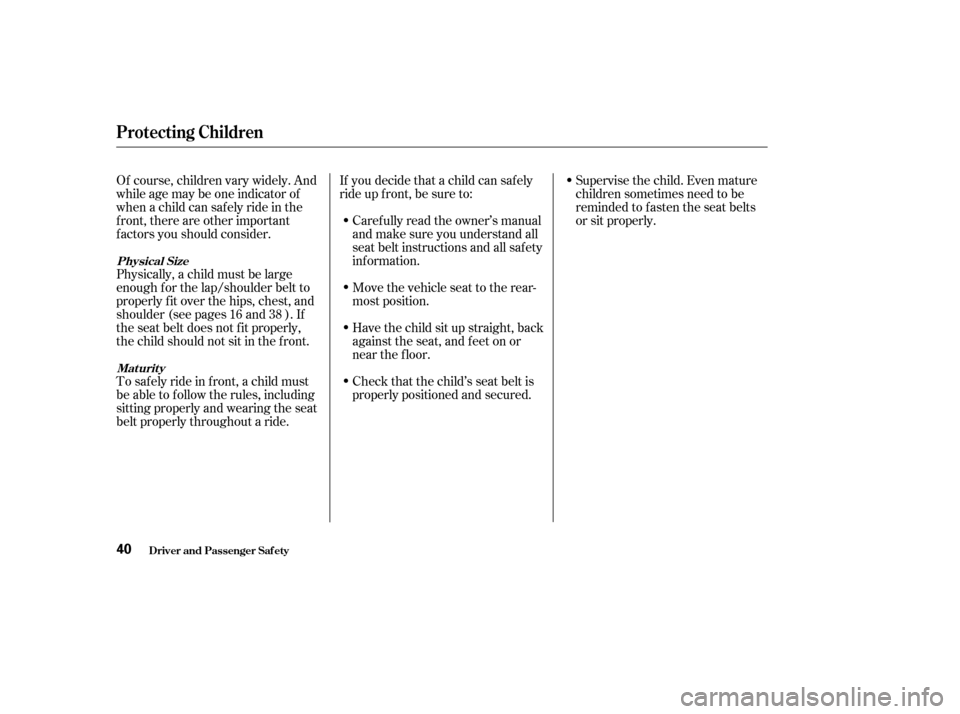
Supervise the child. Even mature
children sometimes need to be
reminded to f asten the seat belts
or sit properly.
If you decide that a child can saf ely
ride up f ront, be sure to:
Caref ully read the owner’s manual
and make sure you understand all
seat belt instructions and all saf ety
inf ormation.
Move the vehicle seat to the rear-
most position.
Have the child sit up straight, back
against the seat, and feet on or
near the f loor.
Check that the child’s seat belt is
properly positioned and secured.
Of course, children vary widely. And
while age may be one indicator of
when a child can saf ely ride in the
f ront, there are other important
f actors you should consider.
Physically, a child must be large
enough f or the lap/shoulder belt to
properly f it over the hips, chest, and
shoulder (see pages and ). If
the seat belt does not f it properly,
the child should not sit in the f ront.
To saf ely ride in f ront, a child must
be able to f ollow the rules, including
sitting properly and wearing the seat
belt properly throughout a ride.
16 38
Physical Size
Maturity
Protecting Children
Driver and Passenger Saf ety40
Page 41 of 319
Your car is equipped with LATCH
(Lower Anchors and Tethers f or
Children) at the rear seats. The
lower anchors are located between
the seat-back and seat bottom and
aretobeusedonlywithachildseat
designed f or use with LATCH.
The exact location of each lower
anchorage is marked with a small
circle above the lower anchorage
point.To install a LATCH-compatible child
seat:
Make sure there are no f oreign
objects around the anchors.
Foreign objects could get in the
way of a secure connection
between the child seat and the
anchors. Put the child seat in the rear lef t
or right vehicle seat and attach the
child seat to the lower anchors
according to the child seat maker’s
instructions.
Move the seat belt buckle or seat
belt tongue away f rom the lower
anchors.
1. 2.
3.
Protecting Children
Driver and Passenger Saf ety
Using L A T CH
42
RRiiggiiddttyyppeeLLOOWWEERRAANNCCHHOORRSS
Page 43 of 319
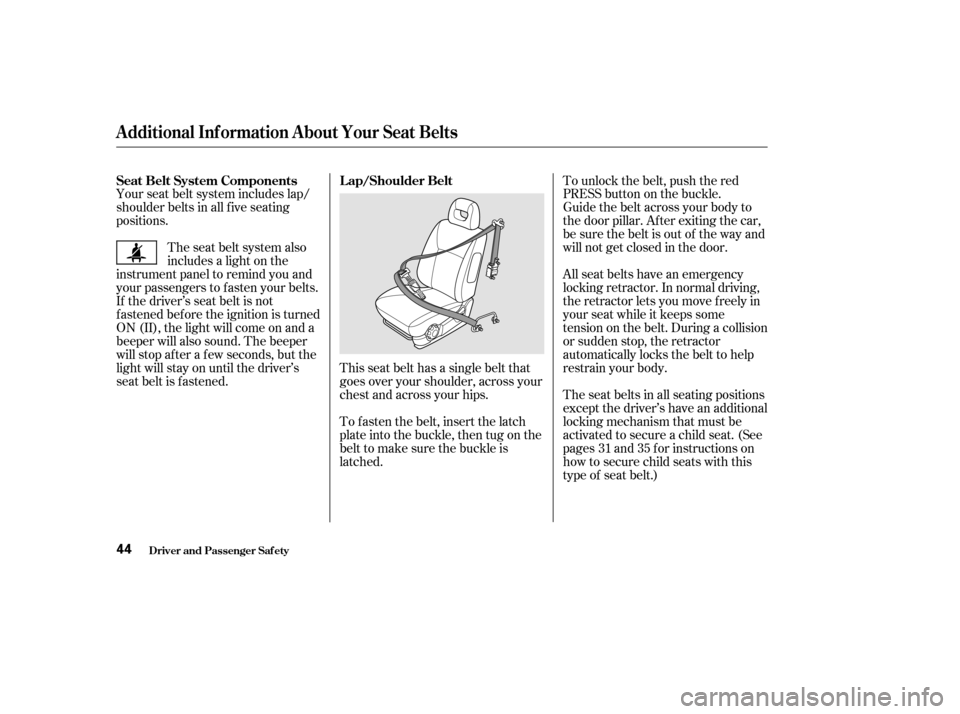
This seat belt has a single belt that
goes over your shoulder, across your
chest and across your hips.
Your seat belt system includes lap/
shoulder belts in all f ive seating
positions.
The seat belt system also
includes a light on the
instrument panel to remind you and
your passengers to f asten your belts.
If the driver’s seat belt is not
fastened before the ignition is turned
ON (II), the light will come on and a
beeper will also sound. The beeper
will stop af ter a f ew seconds, but the
light will stay on until the driver’s
seat belt is f astened. The seat belts in all seating positions
except the driver’s have an additional
locking mechanism that must be
activated to secure a child seat. (See
pages and f or instructions on
how to secure child seats with this
type of seat belt.)
All seat belts have an emergency
locking retractor. In normal driving,
the retractor lets you move f reely in
your seat while it keeps some
tension on the belt. During a collision
or sudden stop, the retractor
automatically locks the belt to help
restrain your body.
Guide the belt across your body to
the door pillar. Af ter exiting the car,
be sure the belt is out of the way and
will not get closed in the door.
To unlock the belt, push the red
PRESSbuttononthebuckle.
To fasten the belt, insert the latch
plate into the buckle, then tug on the
belt to make sure the buckle is
latched. 31 35
Seat Belt System Components L ap/Shoulder Belt
Additional Inf ormation About Your Seat Belts
Driver and Passenger Saf ety44